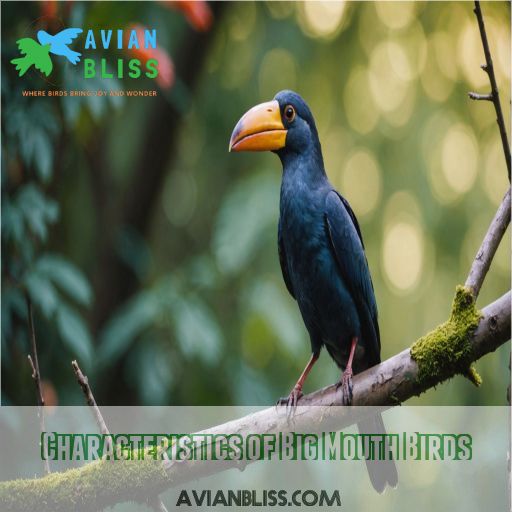This site is supported by our readers. We may earn a commission, at no cost to you, if you purchase through links.
 When you think of a bird with a big mouth, you might picture a pelican with its iconic expandable pouch—a true nature’s fishing net.
When you think of a bird with a big mouth, you might picture a pelican with its iconic expandable pouch—a true nature’s fishing net.
But big-mouthed birds aren’t just about flamboyant fishing techniques. These avian giants have evolved large beaks for plenty of reasons, giving them an edge in food fights and making them standout stars during mating season.
These impressive beaks enable them to navigate diverse environments and play key roles in ecosystems.
More than just beak and brawn, they often shape habitats, influence biodiversity, and, let’s just say, they’re a big deal. Ready to uncover their fascinating world?
Table Of Contents
Key Takeaways
- Nature’s Swiss Army Knives: Birds with big mouths, like toucans and pelicans, have evolved large beaks to rule the food game. These beaks are like tiny Swiss Army knives, letting them adapt to specific environments, dominate food fights, and even put on a dating show with their colorful displays.
- Ecosystem Engineers: Think of these birds as eco-friendly engineers with feathers. They keep ecosystems in check by controlling pest populations, dispersing seeds like confetti, and even promoting plant growth, making them essential to biodiversity and ecological balance.
- Unique Feeding Marvels: Big-mouthed birds rock innovative feeding techniques like the black-crested titmouse’s acrobatic feeding habits. From the flamingo’s classy filtering of tiny crustaceans to the toucan’s clever fruit acrobatics, their specialized beaks and feeding habits make them versatile diners in the natural world.
- Environmental Messengers: These birds also act as nature’s monitors. Changes in their populations can signal shifts in ecosystem health, highlighting the impacts of climate change, pollution, and habitat loss. By keeping an eye on them, we stay informed about our planet’s well-being.
Birds With Large Beaks
If you think having a big mouth is always a minus, then you’re overlooking some of nature’s most amazing creatures with the ultimate big beak advantage.
Birds like pelicans, shoebills, and toucans use their large, uniquely shaped beaks to claim starring roles in their ecosystems, proving that size really does matter in terms of survival and ecological influence.
Evolutionary Advantages of Big Mouths
Imagine birds with massive beaks as nature’s multi-tools, optimized for survival.
Big beaks help dominate food competition through specialized niche occupations, cleverly using beak evolution for diverse survival strategies.
Plus, they make quite the show in mating displays, attracting partners with flair.
These birds, like toucans, excel at adapting to unique environments, highlighting their evolutionary charm.
Unique Feeding Techniques and Adaptations
Birds with large beaks have evolved remarkable feeding adaptations to thrive in their environments.
From the toucan’s serrated beak for crushing fruits (Source) to the pelican’s expandable pouch for scooping up fish, these avian marvels showcase nature’s ingenious solutions for accessing diverse food sources.
Their specialized tongues, keen senses, and efficient digestion further enhance their feeding prowess.
Ecological Roles and Niche Creation
Moving from unique feeding techniques, you find that big-mouth birds play important roles in shaping ecosystems. Their beaks enable creative competition and coevolution, driving resource partitioning and influencing trophic cascades.
These birds provide key ecosystem services, like controlling pests and dispersing seeds.
They’re nature’s multitaskers, ensuring a balance between productivity and sustainability, almost like eco-friendly engineers with feathers.
Examples of Birds With Large Beaks (Pelican, Shoebill, Toucan)
Nature paints a colorful picture with pelicans, shoebills, and toucans using their impressive beak sizes.
Evolution brilliantly crafted these tools, elevating each bird’s diet mastery in their diverse habitats.
Pelicans scoop fish like a pelican-shaped net, shoebills have a poker face while snagging fish, and toucans boast beak functions for fruit foraging.
Plus, they don’t charge for the front-row seats!
Impact on Biodiversity and Ecosystem Balance
Pelicans, Shoebills, and Toucans, with their massive beaks, can shake up ecosystems like rock stars at a concert. They influence biodiversity and balance through:
- Making Habitat Alterations with their nesting habits.
- Playing a part in Trophic Cascades by impacting food web dynamics.
- Igniting Competition Dynamics among species.
- Sometimes acting as Invasive Species.
- Affecting predator-prey relationships for balance.
These birds can alter habitats through their nesting habits, which can reshape the landscape and create new opportunities for other species like those found in Florida.
Trophic cascades occur when the removal or addition of a predator has a ripple effect throughout the food web, impacting the populations of other species.
The presence of these birds can also ignite competition among species, as they may compete for the same resources, such as food or nesting sites.
In some cases, these birds can even act as invasive species, disrupting the balance of native ecosystems.
Characteristics of Big Mouth Birds
Birds with big mouths are truly remarkable creatures.
From their vibrant beaks and expansive gapes to their specialized feathers and lightweight skeletons, these avian wonders are perfectly adapted to thrive in diverse environments.
Beak Shape, Size, and Coloration
Imagine the majesty of a toucan’s beak, where evolution blends style with practicality.
Beak shape and size often mirror a bird’s diet and environment; think of them as a bird’s Swiss army knife.
Vibrant coloration mightn’t just be eye-candy; it’s also a survival tool, with colors warding off predators or attracting mates.
Nature’s design is indeed an artist.
Gape Size and Feeding Mechanisms
Bet your bottom dollar that big beaks aren’t just for show! A bird’s gape size means everything for feeding efficiency. Let’s see how:
- Beak mechanics finesse precise movements.
- Prey size limits dictate a bird’s diet suitability, as seen in the birds that eat butterflies.
- Adaptive radiation allows niche specialization.
- Gape size evolution adapts to environmental changes.
Next up, those fancy feathers take center stage!
Specialized Feathers and Sensory Organs
A bird’s specialized feathers play ingenious roles beyond flight—think sensory marvels!
These adaptations, from bristles aiding prey detection to filoplumes for sensory perception, are communication signals honed by evolutionary origins.
Feather adaptations make birds expert communicators and hunters, like the pelican’s massive beak that scoops up fish.
Picture these vibrant plumes as nature’s radar, keeping big mouth birds a step ahead in their intricate interactions!
Strong, Lightweight Skeletons for Efficient Flight
Birds with big mouths boast remarkably strong, yet lightweight skeletons that enable efficient flight. (Source) Their bones are dense and stiff, optimizing strength-to-weight ratios for soaring and maneuverability.
This evolutionary adaptation:
- Reduces the metabolic cost of flight (Source)
- Enhances wing stroke efficiency
- Allows for fusion of skeletal parts
- Contributes to the birds’ overall lightweight design
Adaptations for Specific Environmental Conditions
Adapting to the environment is like playing a game of survival chess for big-mouthed birds. Their specialized beaks show astounding diversity, perfectly suited to habitat specialization.
With climate change impacts looming, these avian marvels face evolutionary pressures to tweak their behavior.
It’s fascinating how their beaks become not just tools but keys to thriving amidst such challenges. Talk about the ultimate adaptation!
Feeding Strategies of Big Mouth Birds
You’ll be amazed by the clever ways big mouth birds snag their meals, from the flamingo’s graceful filtering to the toucan’s curious tool use.
These birds don’t just survive—they thrive—by using unique strategies like social foraging and opportunistic scavenging, all while sporting their enormous beaks with flair.
Active Foraging and Hunting Techniques
You’ll find big mouth birds exploiting their environment with panache.
Their active foraging and hunting techniques include:
- Mastering predator-prey interactions with agile maneuvers.
- Utilizing camouflage and stealth like nature’s ninjas.
- Engaging in cooperative hunting for efficiency.
- Leveraging sensory adaptations to outsmart prey.
These strategies manage their energy expenditure, proving that survival is both art and science.
Filter Feeding and Straining Mechanisms (Flamingos)
Flamingos are masters of filter feeding, using their uniquely-shaped beaks to efficiently strain small crustaceans, mollusks, and insects from the water.
Their intricate lamellar meshes and back-and-forth lingual pump mechanism allow them to discriminate between food particles, targeting their preferred 2-4 mm size range.
This specialized feeding adaptation gives flamingos a competitive edge in their aquatic environments.
Tool Use and Manipulation of Food Sources (Toucans)
Flamingos might strain their food gracefully, but toucans? They’re the clever Picasso of the bird world! Armed with precision-designed beaks, they manipulate fruits like charming food acrobats.
Imagine them accessing fruit others only dream about—toucan tool use isn’t just clever; it’s a niche exploitation masterpiece.
Their striking beak isn’t just jaw-dropping but serves as nature’s versatile Swiss Army knife!
Scavenging and Opportunistic Feeding Behaviors
Toucans may play with food using their enormous beaks, but they’re also adept at scavenging and seizing opportunities like a savvy bargain hunter. Observing a toucan’s adaptations for scavenging offers a glimpse into:
- Scavenger competition
- Food availability impact
- Evolution of scavenging behavior
- Opportunistic feeding strategies
- Feeling like you’re witnessing nature’s grocery sale!
Scavenging is a key adaptation for toucans.
Adaptations for scavenging allow toucans to thrive in diverse environments.
Toucans are opportunistic feeders, able to capitalize on available resources.
Social Foraging and Cooperative Hunting
Imagine teamwork at its finest, where big-mouth birds nail cooperative hunting.
Social cues, like a quirky bird chat, help them decide group size and prey.
Time for dinner? Communication signals run the show, guiding their hunting strategies like a seasoned conductor.
With mutual understanding, they achieve much more than one bird alone could ever dream of, proving unity packs punch!
Ecological Importance of Big Mouth Birds
Big-mouthed birds play a key role in maintaining the delicate balance of ecosystems.
From dispersing seeds to pollinating plants and controlling predator-prey dynamics, these feathered wonders are true ecosystem engineers, shaping the natural world around them.
Seed Dispersal and Forest Regeneration
Big mouth birds aren’t just about ravenous appetites; they’re nature’s gardeners, tossing seeds across landscapes like confetti at a parade.
Their seed dispersal mechanisms boost forest health by ensuring seed viability.
These feathered frugivores help reforestation strategies flourish, creating homey woodlands.
As fascinating forest health indicators, they prove that sometimes, being a bit of a beakhead is beneficial!
Pollination and Plant Reproduction
Let’s take a closer look at how some big-beaked birds indulge in nature’s buffet, sipping sweet nectar.
These nectar-feeding birds pollinate flowers, unwittingly promoting plant-bird coevolution.
With each beak dive, they transfer pollen, ensuring plant reproduction and contributing to biodiversity.
It’s like nature’s own matchmaking service, where birds and plants make beautiful music—and ecosystems—together.
Predator-Prey Dynamics and Population Control
Imagine you’re watching a big-mouthed bird, like a pelican, snatching fish with delightful finesse.
These avian performers instigate predator-prey cycles, impacting population fluctuations.
Their actions ripple through trophic cascades, influencing ecosystems’ carrying capacity.
This graceful balance in coevolution keeps the habitat thriving by controlling prey populations and adding an unexpected yet delightful splash of drama to nature’s theater.
Nutrient Cycling and Ecosystem Engineering
Birds with large beaks play a major role in nutrient cycling and ecosystem engineering.
They transport nutrients from marine to terrestrial environments, enriching soil fertility and supporting diverse food webs.
For example, seabirds deposit guano that acts as a natural fertilizer, boosting plant growth and attracting other species.
These birds’ unique feeding adaptations make them true ecosystem engineers, shaping the habitats they occupy, such as their specialized bills.
Indicators of Environmental Health and Change
While monitoring bird beak size trends, you might notice that these big-mouthed wonders are nature’s canaries in the coal mine.
By adapting to climate change, they reveal shifts in species distribution.
Pollution effects and habitat fragmentation impact their survival, making them key indicators.
Keep an eye on them—they’re the forecasters of our planet’s health, waving beak-blue flags.
Conservation Status of Big Mouth Birds
When you’re thinking about the conservation status of big mouth birds, you’ve got to think about habitat loss and climate change as their biggest challenges.
But don’t worry—thanks to dedicated conservationists, there’s hope through protected areas and community-driven initiatives that aim to keep these fascinating creatures around for a while.
Threats to Populations and Habitats (Habitat Loss, Climate Change)
You’re sipping coffee, thinking of big-mouthed birds, and boom! They face threats: Habitat loss sneaks up like a silent pickpocket. Climate change? Like a furnace turning the Earth’s dial to “bake.” Now, why does this matter to you?
- Pollution suffocates habitats.
- Invasive species disrupt balance.
- Hunting pressure and disease spread shrink populations.
Who knew birdwatching could be so intense?
Conservation Efforts and Protected Areas
Protecting the future of these magnificent birds requires a multifaceted approach.
Conservation groups are restoring key habitats, creating protected areas, and harnessing the power of ecotourism to generate funding.
But challenges remain – securing adequate resources and fostering community engagement.
By working together globally, we can make sure these winged wonders continue to thrive for generations to come.
Research and Monitoring Programs
Dive into research and monitoring programs, focusing on big mouth birds.
Data collection methods spotlight long-term trends and research funding needs, while ethical considerations make sure minimal impact.
Citizen science involvement can be your ace up the sleeve, turning birdwatching into key contributions.
In this dynamic dance, each participant plays a part, just like a well-tuned orchestra.
Community Engagement and Education Initiatives
Citizen science builds bridges, connecting communities through birdwatching clubs and nature education.
Engage in local conservation endeavors and become a steward of the land.
The thrill of spotting a pelican’s massive beak might inspire educational outreach efforts that ripple across generations!
Like guiding a flock, your involvement carries the weight of change, nurturing a more vibrant, biodiverse world.
Sustainable Coexistence With Human Activities
Picture your backyard as a bustling bird metropolis—embrace bird-friendly agriculture by planting native flora. It’s super important!
Responsible tourism? Keep noise pollution at bay so these birds can chat freely.
Climate change impacts their homes, so consider habitat restoration projects.
Together, let’s make peace with our feathered friends and make sure that big mouths get heard, not harmed.
Frequently Asked Questions (FAQs)
How do big-mouth birds communicate vocally?
Did you know big-mouth birds like crows can mimic over 100 different sounds?
They use their diverse vocalizations, from caws to clicks, to communicate territory, warn of danger, and even bond with their flock.
What myths are associated with big-mouthed birds?
Big-mouthed birds, like certain mythical ones, are often seen as messengers or harbingers in legends.
They may whisper secrets between worlds or symbolize loud proclamations, bridging dimensions with their powerful calls, ensuring no secret stays hidden.
Are there any cultural depictions of big-mouth birds?
So, you think birds with big mouths are just for laughs?
Cultures often depict them in art and folklore to symbolize gluttony or abundance.
Intriguing how one bird can embody both excess and richness, isn’t it?
What are some threats to big-mouth birds habitats?
You’re juggling enough without adding habitat threats for birds with big mouths: habitat loss from human encroachment, climate change altering resources, invasive species wreaking havoc, causing declines faster than a hiccup at a comedy show.
How do beak sizes affect mating rituals?
Birds with larger beaks often struggle to produce complex mating songs, as their "cumbersome musical instruments" limit their vocal range and agility.
Smaller-beaked birds, however, can trill faster and hit a wider array of notes, making them more attractive mates.
Conclusion
Imagine a world without the bird with big mouth—unthinkable, right?
These avian wonders do more than just dazzle with their impressive beaks.
They intricately balance ecosystems by dispersing seeds, controlling pests, and even helping forests grow.
As you learn about their unique lives and adaptations, you’ll see their critical role in nature’s grand performance.
So, next time you spot one, take a moment to appreciate its place in our natural world.
Let’s safeguard these big-beaked beauties.








